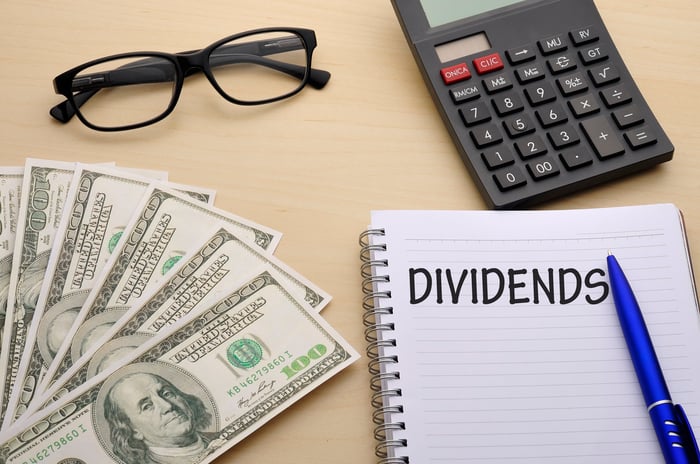Not long ago, I labeled Bristol-Myers Squibb Co. (BMY -0.19%), Eli Lilly and Co. (LLY -0.73%) , Johnson & Johnson (JNJ -2.03%) , and Pfizer Inc. (PFE -0.48%) the best dividend stocks in pharmaceuticals. I still believe all four have what it takes to boost their payouts at a steady clip, but investors still want to know which one rises to the top right now.
Pharma stocks are known for their rapid dividend growth -- and contraction. So rather than focus solely on the common measurements visible at the surface, we'll also need to look under the hood to estimate which of these drugmakers is best positioned to provide heaps of dividend income through your retirement years.

Dividend paying big pharma stocks can put plenty of cash in your retirement fund. Image source: Getty Images.
Surface details
Before diving in, let's get the lay of the land with a look at the yield you'd receive buying each stock at recent prices, as well as their histories of annual raises, and recent rates of distribution growth.
At first glance, it looks like the race is over for Eli Lilly before it even gets started. The company froze its payout for several years, then began making minuscule increases in just four years ago. To top it off, the stock offers the lowest yield at recent prices.
| Big Pharma Stock | Forward Yield | Consecutive Annual Increases | 5-Year Annual Dividend Growth Rate |
| Bristol-Myers Squibb | 2.88% | 8 | 2.9% |
| Eli Lilly | 2.61% | 4 | 1.2% |
| Johnson & Johnson | 2.62% | 55 | 7% |
| Pfizer | 3.91% | 7 | 8.4% |
By the same yardsticks, Bristol-Myers Squibb looks a bit more attractive than Eli Lilly, but a 2.9% annual growth rate over the past five years isn't terribly inspiring.
If you're willing to overlook the 50% payout slash Pfizer's shareholders endured in 2009, the stock's forward yield and recent dividend growth rate put it in the lead. Over a longer time frame, though, Johnson & Johnson shareholders have come out miles ahead.
Room to grow
A bigger yield today won't help you retire much faster, though, if the underlying business can't keep generating enough cash to make the payments. One of the easiest ways to gauge the likelihood of large payout bumps ahead is to look at the proportion of profits each company is using to make payments at their current level.
Again, the view from the surface doesn't tell the full story. As a proportion of earnings, Bristol and Lilly appear to be shoveling every penny of profit to shareholders, without anything left over to invest in the core business. As a proportion of free cash flow, however, both companies appear to have plenty of room to continue boosting their payouts.
BMY Payout Ratio (TTM) data by YCharts
The opposite can be said for Bristol-Myers Squibb. Non-recurring income from recent divestitures and legal settlements has inflated the company's official earnings recently. While Bristol's standard payout ratio puts it on even footing with Johnson & Johnson, the company used 95.7% of free cash flow generated over the past year to make payments.
Looking ahead to pick a winner
Based on their recent performances, Bristol-Myers Squibb and Eli Lilly look like they wandered into the wrong tournament. Surging sales of recently launched drugs, though, make both look far more enticing. In the first quarter, Bristol reported more than $1.1 billion in sales for Opdivo and Eliquis, with increases of 60% and 50%, respectively, over the same period last year. With these blockbusters leading the charge, the average analyst following the stock expects Bristol's bottom line to expand at a 9.2% annual rate over the next five years.
The long-term outlook for Eli Lilly is even rosier. Sales of newer diabetes treatments Trulicity and Jardiance rose 160% and 94%, respectively, in the first quarter. Continued success in the large and growing diabetes space is expected to help Lilly grow earnings by 12.3% annually over the next five years.
Pfizer also boasts a handful of successful new drugs -- for example, breast cancer treatment Ibrance, which saw year-over-year sales jump 58% in the first quarter -- but a huge lineup of aging products with declining sales dragged total revenue 2% lower.

Image source: Getty Images.
That brings us to the "Goldilocks" stock among these four: Johnson & Johnson. A majority of the $72.2 billion in total revenue it generated last year came from sales of branded consumer goods and medical devices. These segments generate reliable profits, but their sales are growing more slowly than pharmaceuticals. That said, J&J recently highlighted plans to launch or file applications for 10 new drug candidates with blockbuster potential.
Adding a slate of new drugs to an already successful product lineup is expected to boost Johnson & Johnson's bottom line by about 6.5% annually over the next five years. Granted, that's a slower growth rate than is forecast for Lilly and Bristol, but J&J's diverse revenue stream means you can be far more confident about its ability to maintain a steady pace of dividend increases into and throughout your retirement years. And that makes it the best dividend stock in big pharma.






